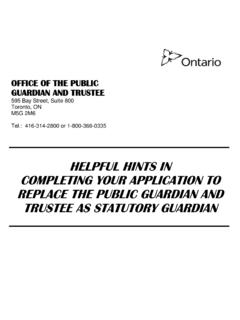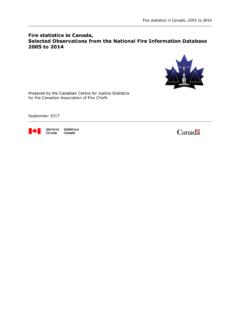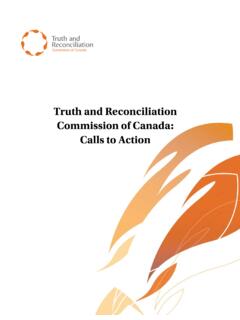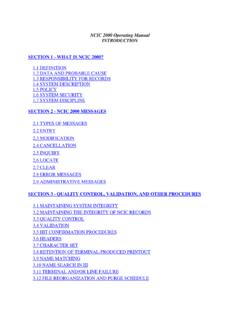Transcription of Aboriginal Peoples and the Criminal Justice System
1 Aboriginal Peoples and the Criminal Justice System Jonathan Rudin Opinions expressed are those of the author and do not necessarily reflect those of the Ipperwash Inquiry or the Commissioner. EXECUTIVE SUMMARY This paper, written for the Ipperwash Inquiry, deals with the relationship between Aboriginal people and the Criminal Justice System , with particular emphasis on the situation of Aboriginal people in Ontario. The paper argues that an understanding of the dynamics of this relationship helps explain the way in which attitudes and responses to events such as the occupation of Ipperwash Park can be understood. Further, unless changes are made in this relationship, similar responses from both Aboriginal and non- Aboriginal people can be expected. Aboriginal overrepresentation in the Criminal Justice System is one of the clearest markers of what the Supreme Court of Canada has referred to as a crisis in the canadian Justice System .
2 Aboriginal overrepresentation is often thought of as a problem in western Canada but, in fact, Ontario ranks third in terms of overrepresentation across the country. Aboriginal youth are overrepresented in Ontario correctional facilities at a much higher rate than Aboriginal adults. While recent sentencing amendments and Supreme Court decisions have led to a lowering of the overall jail population, the drop in Aboriginal admissions is much smaller than that of non- Aboriginal admissions. This is true in both the adult and youth Justice spheres. This suggests that overrepresentation will continue to be a problem for the years to come. In order to address this problem, it is first necessary to understand what the major causes of the problem are. The three explanations that have been advanced as significant causal factors are: 1) culture clash, 2) socio-economic, and 3) colonialism. While all three explanations have their strengths, the paper agrees with the Royal Commission on Aboriginal Peoples and other commissions and reports that it is the experience of colonialism that best explains the persistence of Aboriginal overrepresentation.
3 While overrepresentation may be the most obvious example of the problems Aboriginal people have with the Criminal Justice System , in many ways over- and under-policing, although more difficult to demonstrate statistically, are equally serious. Over-policing refers to the practice of police targeting people of particular ethnic or racial backgrounds or people who live in particular neighbourhoods. While Aboriginal people are clearly over-policed today, over-policing has a particular history with regards to Aboriginal people. Governments in Canada have historically used the police to pre-emptively attempt to resolve Aboriginal rights disputes by arresting those attempting to exercise those rights prior to any determination as to the validity of the claims. In addition, police have been used to further the objectives of the government in terms of assimilation of Aboriginal people through apprehension of children in order to have them attend residential school, and later in support of child welfare agencies.
4 Police also were used to support many of the most egregious provisions of the Indian Act. The impact of over-policing has led to a great distrust of the police by Aboriginal people. Over-policing also leads to the police forming attitudes that view Aboriginal people as violent, dangerous, and prone to Criminal behaviour. These sorts of attitudes are not counteracted by Aboriginal awareness programs or similar initiatives. At the same time, Aboriginal people are also under-policed. Aboriginal people are not only overrepresented in the Criminal Justice System as accused persons, but as victims as well. Nevertheless, Aboriginal people are often seen as less worthy victims by the police, and thus 1 requests for assistance are often ignored or downplayed. This attitude is mirrored by governments who also routinely downplay the significance of Aboriginal rights claims and ignore long-standing grievances. Just as over-policing has a significant impact on Aboriginal Peoples attitudes toward the police, under-policing also plays a great role in fostering a deep distrust of police.
5 Under-policing and over-policing are really two sides of the same coin. Governments and the courts have undertaken a number of initiatives to address the problems discussed in this paper. In 1996, the sentencing provisions of the Criminal Code were significantly amended. Among the amendments was s. (e), which instructs judges to look for all alternatives to imprisonment that are reasonable in the circumstances for all offenders with particular attention to the circumstances of Aboriginal offenders. The meaning of this section was elaborated upon by the Supreme Court of Canada in the 1999 decision of R. v. Gladue. Subsequent to Gladue, the federal government, in the 2001 Throne Speech, pledged to eliminate Aboriginal overrepresentation within a generation. There are a number of specific programs funded by both the federal and provincial governments that are meant to address overrepresentation and related issues. Aboriginal Courtworkers have been in place in Ontario since the 1970s.
6 In the 1990s, both levels of government began funding Aboriginal Justice programs that were specifically aimed to take Aboriginal offenders out of the Criminal Justice System and have them dealt with in more culturally appropriate and meaningful ways. In Ontario, Legal Aid Ontario has also funded some of these programs. In Toronto, the Gladue ( Aboriginal Persons) Court was established in 2001 to allow judges to truly respond to the Gladue decision. The court has a number of specific resources available to it in its work. One of the most important is the presence of a Gladue Caseworker who writes Gladue Reports, providing the sentencing judge with valuable information on the life circumstances of the offender and also possible recommendations for sentences that can address the problems that have brought the individual before the court. Despite these initiatives, Aboriginal overrepresentation and concerns about over- and under-policing have not diminished in any significant way in the past 10 to 15 years.
7 Among the reasons for this are the real systemic barriers to change in the Criminal Justice System . The Gladue decision is not a sentencing discount case. The decision requires judges to approach the sentencing of an Aboriginal offender in a different manner. Crucial to this approach is the provision of information that the judge can use to craft the type of restorative sentence contemplated by the decision. Unfortunately, outside of the Gladue Court and the recent expansion of the Gladue Caseworker program by Aboriginal Legal Services of Toronto, judges are generally not getting the information they require to make Gladue meaningful to Aboriginal offenders before the court. A further systemic issue that has blunted the impact of Gladue is the tendency of many Aboriginal accused persons to plead guilty to their offences if they are denied bail. In Ontario, there has been a significant rise in the remand population those held in custody while awaiting trial while there has been a reduction in custodial sentences imposed after a finding of guilt.
8 This development means that many offenders are essentially receiving time-served sentences. 2 A number of factors work together to make Aboriginal people more likely to be denied bail or to be unable to meet bail conditions. While Aboriginal Justice programs may have the potential to make a positive impact on overrepresentation, the fact that many programs are relatively new and take on a limited range of offenders means that their potential has yet to be reached. In order for these programs to make a difference, Crown Attorneys must be willing to have matters that would otherwise result in jail sentences referred to these programs. While some of the changes necessary to address the root causes of why Aboriginal people appear before the courts and are sentenced to jail in disproportionate numbers lie outside of the Justice System , it is possible to make changes within the System that can have a real and significant impact. It is vital that such changes be undertaken in order that Aboriginal people experience the Criminal Justice System as one that can actually serve their needs.
9 If the System is not changed, it will remain unable to resolve disputes such as the one that arose in Ipperwash. This report recommends that: In order to make the promise of s. (e) and the Gladue decision real, the Province of Ontario create a Gladue Caseworker program throughout the province. The province develop a concrete plan to expand the range of Aboriginal Justice programs and commit to ongoing funding for such programs. While the issue of policing is the subject of other papers written for the Ipperwash Inquiry, there is no question that change in the policing area must be of a substantive nature. The addition of an Aboriginal awareness program or a push to recruit Aboriginal people to join the police force will have no impact if the dynamics within the police force itself do not change. The delivery of victims services to Aboriginal people should be undertaken directly by Aboriginal organizations. In this context the concept of what constitutes victims services should be expanded to meet the real needs of Aboriginal people.
10 It is recommended that the province undertake substantive consultations with Aboriginal organizations that might be affected by the development of government policies regarding Aboriginal and restorative Justice initiatives. Crown policies of general application be examined for their impact on Aboriginal people charged with Criminal offences. The province fund Aboriginal -specific Bail Programs where numbers warrant. The Ministry of the Attorney General accept the decision of Mr. Justice Archibald in R v. Bain and instruct local Crowns that the Gladue principles apply at bail hearings. 3 INTRODUCTION This paper, written for the Ipperwash Inquiry, deals with Aboriginal people and the Criminal Justice System , with particular emphasis on the situation of Aboriginal people in Ontario. In this paper, issues relating to overrepresentation of Aboriginal people in prison, the overrepresentation of Aboriginal people as victims of crime, and over- and under-policing of Aboriginal people will be examined.











